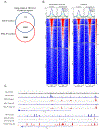Aberrant Expression of ERG Promotes Resistance to Combined PI3K and AR Pathway Inhibition through Maintenance of AR Target Genes
- PMID: 31296553
- PMCID: PMC6726496
- DOI: 10.1158/1535-7163.MCT-18-1386
Aberrant Expression of ERG Promotes Resistance to Combined PI3K and AR Pathway Inhibition through Maintenance of AR Target Genes
Abstract
On the basis of our previous work defining the molecular rationale for combined targeting of the PI3K and AR pathways in PTEN loss prostate cancer, the first clinical trial was recently reported demonstrating a significant benefit for combination therapy in patients with metastatic prostate cancer. In this phase II trial, loss of PTEN was a biomarker predictive of response to combined AKT and AR inhibition. Given that PTEN loss prostate cancers are significantly enriched for ERG genomic rearrangements, we evaluated how the aberrant expression of ERG may impact response to PI3K/AR-targeted therapy. Here, we show that overexpression of ERG in the setting of Pten loss promotes resistance to combined PI3K and AR pathway inhibition with associated maintenance of AR target gene expression. Importantly, following AR knockout in the setting of ERG overexpression, there is maintenance of a subset of AR lineage-specific target genes, making AR dispensable in this context. This has important clinical implications as even in the setting of the androgen-regulated TMPRSS2:ERG genomic rearrangement, ERG expression is never abolished following AR inhibition and may allow for cell survival following AR (lineage)-targeted therapies.
©2019 American Association for Cancer Research.
Conflict of interest statement
Figures





Similar articles
-
Oncogenic ERG Represses PI3K Signaling through Downregulation of IRS2.Cancer Res. 2020 Apr 1;80(7):1428-1437. doi: 10.1158/0008-5472.CAN-19-1394. Epub 2020 Feb 3. Cancer Res. 2020. PMID: 32015092 Free PMC article.
-
TMPRSS2-ERG Controls Luminal Epithelial Lineage and Antiandrogen Sensitivity in PTEN and TP53-Mutated Prostate Cancer.Clin Cancer Res. 2018 Sep 15;24(18):4551-4565. doi: 10.1158/1078-0432.CCR-18-0653. Epub 2018 May 29. Clin Cancer Res. 2018. PMID: 29844131 Free PMC article.
-
High Efficacy of Combination Therapy Using PI3K/AKT Inhibitors with Androgen Deprivation in Prostate Cancer Preclinical Models.Eur Urol. 2015 Jun;67(6):1177-1185. doi: 10.1016/j.eururo.2014.08.053. Epub 2014 Sep 12. Eur Urol. 2015. PMID: 25220373
-
Role of PI3K-AKT-mTOR Pathway as a Pro-Survival Signaling and Resistance-Mediating Mechanism to Therapy of Prostate Cancer.Int J Mol Sci. 2021 Oct 14;22(20):11088. doi: 10.3390/ijms222011088. Int J Mol Sci. 2021. PMID: 34681745 Free PMC article. Review.
-
Interplay Among PI3K/AKT, PTEN/FOXO and AR Signaling in Prostate Cancer.Adv Exp Med Biol. 2019;1210:319-331. doi: 10.1007/978-3-030-32656-2_14. Adv Exp Med Biol. 2019. PMID: 31900915 Review.
Cited by
-
ERG-driven prostate cancer initiation is cell-context dependent and requires KMT2A and DOT1L.Nat Genet. 2025 Aug 26. doi: 10.1038/s41588-025-02289-w. Online ahead of print. Nat Genet. 2025. PMID: 40858905
-
FKBP5 Exacerbates Impairments in Cerebral Ischemic Stroke by Inducing Autophagy via the AKT/FOXO3 Pathway.Front Cell Neurosci. 2020 Jul 15;14:193. doi: 10.3389/fncel.2020.00193. eCollection 2020. Front Cell Neurosci. 2020. PMID: 32760250 Free PMC article.
-
The Expression of Proto-Oncogene ETS-Related Gene (ERG) Plays a Central Role in the Oncogenic Mechanism Involved in the Development and Progression of Prostate Cancer.Int J Mol Sci. 2022 Apr 26;23(9):4772. doi: 10.3390/ijms23094772. Int J Mol Sci. 2022. PMID: 35563163 Free PMC article. Review.
-
Allosteric interactions prime androgen receptor dimerization and activation.Mol Cell. 2022 Jun 2;82(11):2021-2031.e5. doi: 10.1016/j.molcel.2022.03.035. Epub 2022 Apr 20. Mol Cell. 2022. PMID: 35447082 Free PMC article.
-
ERG activates a stem-like proliferation-differentiation program in prostate epithelial cells with mixed basal-luminal identity.bioRxiv [Preprint]. 2024 Apr 6:2023.05.15.540839. doi: 10.1101/2023.05.15.540839. bioRxiv. 2024. PMID: 38585869 Free PMC article. Preprint.
References
-
- Robinson D, Van Allen EM, Wu YM, Schultz N, Lonigro RJ, Mosquera JM, et al. Integrative Clinical Genomics of Advanced Prostate Cancer. Cell 2015;162:454. - PubMed
Publication types
MeSH terms
Substances
Grants and funding
LinkOut - more resources
Full Text Sources
Medical
Molecular Biology Databases
Research Materials

